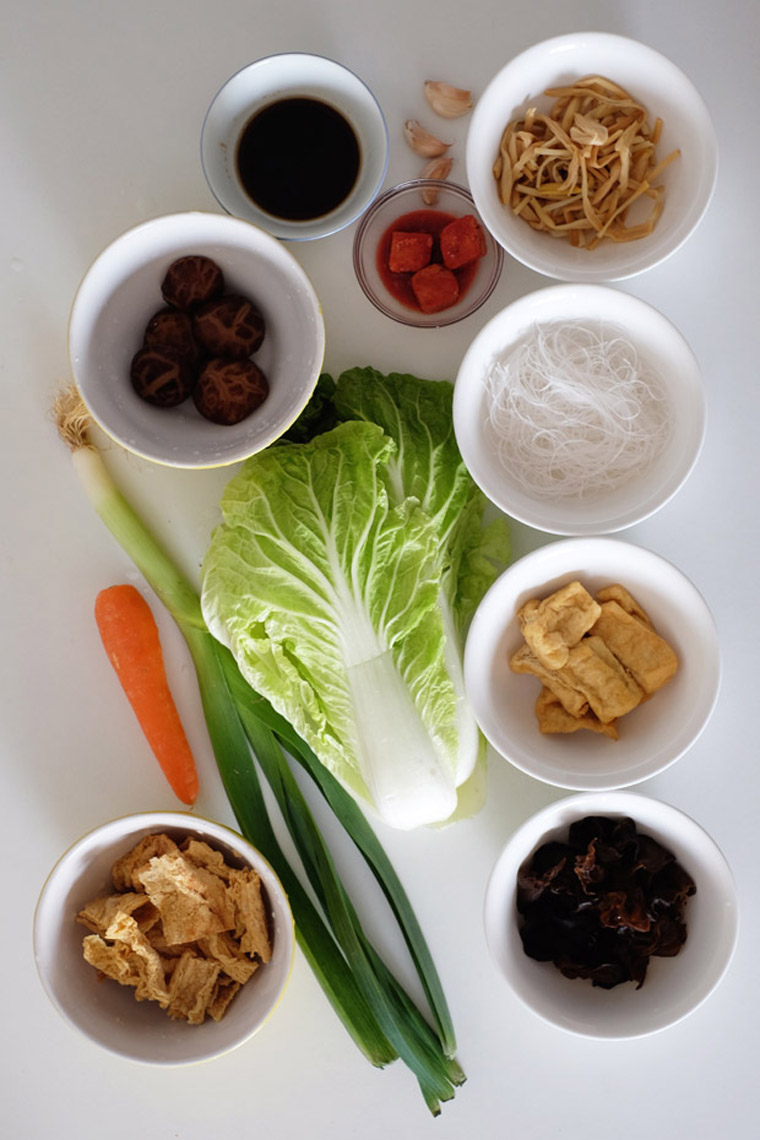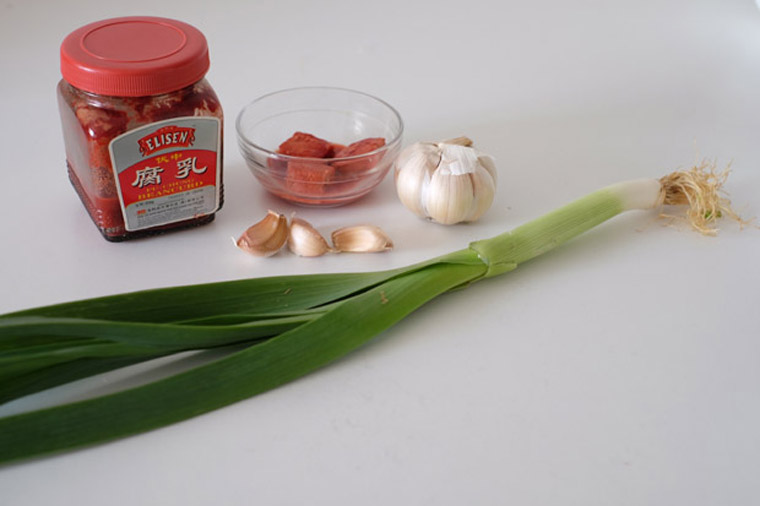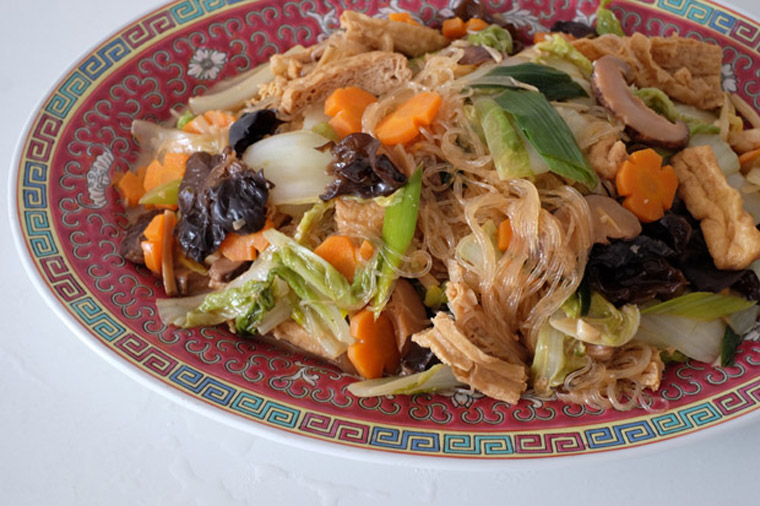Many Chinese begin the morning of Lunar New Year with Buddha’s Delight or Lo Hon Zai (simplified Chinese: 罗汉菜; traditional Chinese: 羅漢菜). As it’s a mixed vegetables dish, commonly known as chap chai (literally: mixed vegetables in Chinese).
This dish is named as such because it is traditionally eaten by Buddhist monks who are vegetarians. Various vegetables are cooked in soy-based seasoning until tender. In Nyonya chap chai, fermented soy bean paste (tau cheong) is used and often added with prawns.
COMMONLY USED INGREDIENTS
According to wikipedia, these are the commonly used ingredients (source). Pick and choose ingredients that you and your family likes.
- Arrowhead (慈菇; pinyin: cí gū)
- Bamboo fungus (竹笙, pinyin: zhúshēng or 竹荪; pinyin: zhúsūn)
- Bamboo shoots (simplified: 笋; traditional; 筍; pinyin: sǔn)
- Bean curd sticks (腐竹; pinyin: fǔ zhú; also called “tofu bamboo”
- Black mushrooms (冬菇; pinyin: dōnggū)
- Carrot (traditional: 胡蘿蔔; simplified: 胡萝卜, pinyin: hú luóbo; or traditional: 紅蘿蔔; simplified: 红萝卜, pinyin: hóng luóbo)
- Cellophane noodles (粉絲; pinyin: fěn sī; also called “bean threads”)
- Daylily buds (金针; pinyin: jīnzhēn; also called “golden needles”)
- Fat choy (traditional: 髮菜; simplified: 发菜; pinyin: fàcài; a black hair-like cyanobacteria)
- Ginkgo nuts (traditional: 銀杏; simplified: 银杏, pinyin: yín xìng; or 白果, pinyin: bái guǒ)
- Lotus seeds (蓮子; pinyin: liánzǐ)
- Napa cabbage (大白菜; pinyin: dà báicài)
- Peanuts (花生; pinyin: huāshēng)
- Snow peas (traditional: 荷蘭豆; simplified: 荷兰豆; pinyin: hélándòu)
- Fried tofu (炸豆腐; pinyin: zhá dòufǔ)
- Water chestnuts (traditional: 荸薺; simplified: 荸荠; pinyin: bíqí)
- Fried or braised wheat gluten (traditional: 麵筋, simplified: 面筋; pinyin: miàn jīn)
- Wood ear (木耳; pinyin: mù ěr; also called black fungus)

AUSPICIOUS INGREDIENTS
For the purpose of Chinese New Year celebration, I chose nine ingredients which number represents longevity. Each of the ingredients are auspicious, and which gives the dish both colour and texture. They are also easily available where I am.
- Leek – Wealth
- Chinese (pak choy, 白菜) – hundreds of prosperity
- Carrot – Red represents good luck
- Shiitake Mushrooms – Longevity
- Wood Ear Fungus – Longevity
- Golden lily buds (金针; jīnzhēn) – Wealth
- Fried tofu puff (豆腐, dòu fǔ)- Fulfillment of wealth and happiness
- Bean curd sticks (腐竹; fǔ zhú) – Blessing the house
- Glass noodles – Long, unbroken noodles symbolise long life

TOOLS
- Wok + spatula
- Knife + chopping board
- Mixing bowls to soak vegetables
- Small bowls to wash and place cooking ingredients
- Teaspoons (to crush beancurd/ mix seasonings)
- Serving plate
RECIPE CARD
BUDDHA’S DELIGHT (LO HON ZAI/ 罗汉菜)
Ingredients
- AROMATICS:
- 3 tbsp Vegetable oil
- 3 cubes Red fermented bean curd
- 3 cloves Garlic, minced
- VEGETABLES:
- 1 Leek, medium size, chopped
- 5 dried Chinese mushrooms, soaked and sliced
- 1/4 cups (10 g) Dried wood ears fungus, soaked and chopped
- 1/4 cup (20 g) Dried lily flowers, soaked and tied
- 1 (350 g) Chinese cabbage, chopped into 2 inches
- 3 sticks Dried bean curd sticks
- 1/2 cup Fried tofu puff
- 1 Large carrot, sliced
- 1 small (20 g) Glass noodles, soaked
- 1 1/2 cup water
- SEASONINGS:
- 2 tsp Sugar
- 1 tsp Sesame oil
- 2 tbsp Soy sauce
Directions
- Step 1 SOAK VEGETABLES: Soak the fungus, mushroom, lily buds, beancurd sticks and glass noodles in water for 15 minutes, or until soft.
- Step 2 MAKE SEASONINGS: In a bowl, add 2 tsp of sugar, 1 tsp of sesame oil and 2 tbsp of soy sauce.
- Step 3 CHOP VEGETABLES: Soak Chinese cabbage and chop into 2 inch pieces. Peel and slice carrots. Chop leek into 2 inch horizontal pieces, then separate the white and green portion. Remove hard bits from the black fungus and tear bigger ones into small pieces. Snip off hard tips from lily buds and tie a knot in the middle of each strand. Chop beancurd into 2 inch length. Cut off hard stems from mushrooms and slice thinly. Mince garlic.
- Step 4 FRY AROMATICS: Heat 3 tbsp of oil in medium fire. When oil sizzles, add the red fermented bean curd, garlic and the white portions of the leeks (2 min).
- Step 5 FRY VEGETABLES: Then stir-fry mushrooms, wood ear fungus, and lily flowers until fragrant (2 min) Next, add the carrots, cabbage, green part of the leek and fried tofu. Turn on heat to the highest and. Stir-fry until everything is fragrant (4 min)
- Step 6 BRAISE VEGETABLES: Add 1 1/2 cup of water and dried beancurd. Gather all vegetables in the middle of the wok to ensure they are soaked in the water. Cover the wok with a lid, and reduce the heat to medium. Cook until vegetables are soften and stir occasionally (5 min). Remove the lid, pour in glass noodles and seasonings. Turn on heat to its highest. Stir until most of the liquid has evaporated (3 min).
- Step 7 SERVE: Dish out on a large and beautiful plate.
SHORT RECIPE
Fry 3 cubes fermented bean curd + 2 cloves minced garlic + white leeks in 3 tbsp of oil (2 min). Add and fry mushroom + wood ear fungus + lily flower (2 min). Add and fry carrot + cabbage + green leek + tofu (4 min). Pour 1.5 cup water and dried beancurd, cover and braise for 5 min. Add glass noodles + seasonings (2 tsp sugar + 1 tsp sesame oil + 2 tbsp soy sauce). Turn on heat to its highest and stir until most of the liquid has evaporated (3 min).
COOKING TIPS:
AUTHENTIC BUDDHA’S DELIGHT: Keeping it strictly vegetarian.
Traditional Buddha’s Delight must not have garlic or leek. Pungent herbs – such as leek, onion, garlic – are avoided in some vegetarian diet. They are considered to be ‘hot’, and are believed to increase lust and anger (source: Bodhisattva Precepts)
On Five Pungent Herbs
A disciple of the Buddha should not eat the five pungent herbs — garlic, chives, leeks, onions, and asafoetida. This is so even if they are added as flavoring to other main dishes. Hence, if he deliberately does so, he commits a secondary offense.Pungent herbs: “They are: leek, onion, garlic, and a few other such herbs such as asafoetida, an ingredient common in curries etc. Eaten raw they are believed to incite people to anger and disputes; eaten cooked they increase one’s sexual desire.” Buddhist adepts are advised to avoid them, as their consumption tends to disturb the peacefulness of the mind. “According to the [Surangama Sutra], garlic, three kinds of onions, and leeks are the five forbidden pungent roots. ‘If eaten raw, they are said to cause irritability of temper, and if eaten cooked, to act as an aphrodisiac; moreover, the breath of the eater, if reading the sutras, will drive away the good spirits.’”

You can omit garlic, leek and even fermented beancurd if you like. In that case, instead of frying garlic and fermented bean curd, start with frying shiitake mushroom to compensate the flavour. Mushrooms, like garlic, contain glutamate (a compound in MSG) which gives a good umami taste.
However, the addition of garlic and especially red fermented beancurd adds another dimension to the dish. Do include them if you’re not particular about making traditional Buddha’s Delight; it’s so much more delicious!
Do you normally have the strict Buddhist version of this dish?


Pingback: Dried Chinese Black Mushrooms (Shittake Mushrooms) – New Malaysian Kitchen
Pingback: Vegetarian Fried Prawns/ Fried Cauliflower – New Malaysian Kitchen
Pingback: Recipe: Vegetarian Fried Prawns – JewelPie
Pingback: 這個年初一,我 4:30am 在吃齋菜。 | Charis Hung | 本土文集